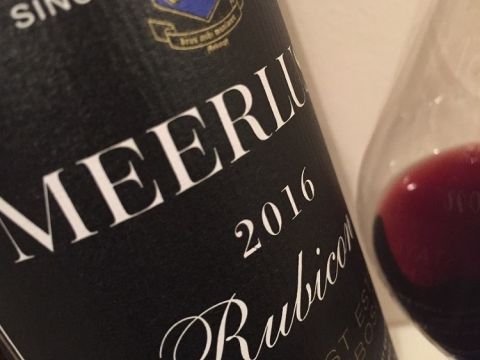3 April 2020 Amid all the excitement about new-wave South Africa, we should not overlook its classic wines.
From 409 rand, €23.80, 259 Swedish kronor, £23.50, $29.99, AU$49.95, HK$245
My wine of the week is a South African classic, which is something of a feat given how South Africa’s vibrant, exciting wine industry has evolved in the last three, post-apartheid decades.
The importance of wines such as Meerlust Rubicon should not be overlooked as milestones in the developing history of South African wine. First made in 1980, it essentially set the pattern for Bordeaux blends in the country. A couple of well-regarded varietal Cabernet Sauvignons pre-date it, most notably Kanonkop’s in 1973 and Meerlust’s own in 1975, but Rubicon established the blended category that wines such as Kanonkop’s Paul Sauer now so ably represent.
To understand how revolutionary this was back in the 1970s, we should consider a couple of key facts. Today, with 10,233 ha (25,284 acres), Cabernet Sauvignon is the most widely planted red wine grape variety in South Africa, making up 11% of the vineyard area, and is the third most planted overall. Moreover, Stellenbosch has made Cabernet Sauvignon and Cabernet blends something of a local signature, attracting even the high-profile May-Eliane de Lencquesaing from Ch Pichon Lalande in Pauillac to establish Glenelly there to make Cabernet and friends [as well as very good Chardonnay – JH].
But, as I noted in my earlier wine of the week, Reyneke, Organic Chenin Blanc 2018/19 Western Cape, this is a very recent phenomenon. Of those 10,233 ha, only 1,721 are more than 20 years old. Barely 32 ha qualify for Old Vines Project status at 35 or more years of age, and fewer than 14 ha of them are in Stellenbosch. Old-vine Merlot or Cabernet Franc for blending? Forget it. Paarl just about scrapes together 0.61 and 0.55 ha respectively.
Nico Myburgh, father of the current Meerlust proprietor Hannes Myburgh, was therefore extraordinarily prescient in creating Rubicon, and justified by history in choosing to name it for Caesar’s crossing of the Rubicon river in Italy, after which Things Were Never The Same Again.
Hannes is the eighth generation of the Myburgh family to own the Meerlust farm in the western end of Stellenbosch, closest to the sea at False Bay (Meerlust means ‘pleasure of the sea’). In the family since 1756, the property is blessed with attractive Cape Dutch architecture aplenty, making the tasting room a worthwhile stopping point en route to or from the airport. It is a National Monument, no less.
Long-established the estate may be – and comparatively long-established the Meerlust wine brand is in South African terms – but the creation of Rubicon was not the Myburghs' last forward-thinking project. Particularly noteworthy has been Hannes’ engagement with the black economic empowerment movement.
Since 2009, a programme has been in place to give long-standing farm workers meaningful involvement in the wine industry: homes, land and a wine storage-cum-labelling facility. The Compagniesdrift project is a positive step in the right direction, alongside related community projects funded by the Myburghs.
It is one thing to launch a category, but quite another to do it well. A cursory glance at our tasting notes database shows how good a job Meerlust have done with Rubicon. It regularly scores 17 and 17.5 and carries a track record for ageworthiness, with Richard giving 20-year drinking windows for both the 2009 and 2015 vintages.
The vintage I have chosen, 2016, probably has more of a seven- to nine-year window, not least because it is drinking so beautifully now that I suspect people will struggle to stop themselves opening it. I was hard pressed to make a bottle last two nights, between me, myself and I. Its tannins are present, but supple and plump, and backed with a certain freshness of acidity as a counterpoint to its nicely ripe black fruit. It is lip-smacking and moreish.
Curious about its approachability, I had a look at the technical sheet for the 2016. Unlike many a tech sheet, this proved highly informative. Chris Williams, winemaker at Meerlust (whose personal wine label is The Foundry), explained that 2016 was dry (year two of the three-year Cape drought) but cool. The coolness perhaps explains both the freshness of fruit and the fine thread of acidity (TA 5.9 g/l, pH 3.52 for those interested).
More importantly, uneven fruit set and slow ripening meant uneven ripeness in the Cabernet Sauvignon while Merlot apparently shone. Consequently, the 49% Cabernet Sauvignon in the blend is the lowest in Rubicon history, with 28% Merlot, 20% Cabernet Franc and 3% Petit Verdot making up the remainder. In addition, extraction during fermentation was deliberately gentle with the Cabernet, reflected in the supple tannic structure.
The wine spent 16 months in 55% new Nevers oak barrels, with the oak giving cedar and some incense-like spice notes which worked in harmony with tobacco-leaf aromas that are most likely from the Cabernet Franc component. This was a wine that brought a smile to my face, which is just what an impulse purchase on the way home should do. I scored it 17/20.
Finally, if it is one thing to launch a category and another to do it well, then it is yet another to do it at reasonable prices with wide availability. Thankfully, Rubicon hits these points too. Wine-Searcher shows it will set UK buyers back £23.50, US $29.99 and €23.80 for those in continental Europe, with plenty of availability in other markets, not least in South Africa itself.















